Abstract
The incidence of ADHD appears to be similar in African Americans and white populations. However, fewer African-American than white children are diagnosed and treated for ADHD. Reasons for this disparity have not been fully elucidated; causes are most likely complex. Whereas certain barriers to treatment are driven by patients and their families, others are due to limitations in the healthcare system. Patient-driven obstacles to care include inadequate knowledge regarding the symptoms, treatment and consequences of untreated ADHD and fear of overdiagnosis and misdiagnosis. A survey conducted to explore cultural differences between African-American and white respondents found that African Americans were more likely than whites to be unfamiliar with ADHD. In addition, African Americans felt that they were diagnosed with ADHD more often than whites and that teachers blamed ADHD for learning or behavior problems more often in African Americans. Health system barriers include a lack of culturally competent healthcare providers, stereotyping/biases and failure of the clinician to evaluate the child in multiple settings before diagnosis. Strategies to overcome these challenges include increased dissemination of ADHD information through community events; improved training of clinicians in cultural competence; and open communication among parents, clinicians and school personnel.
Full text
PDF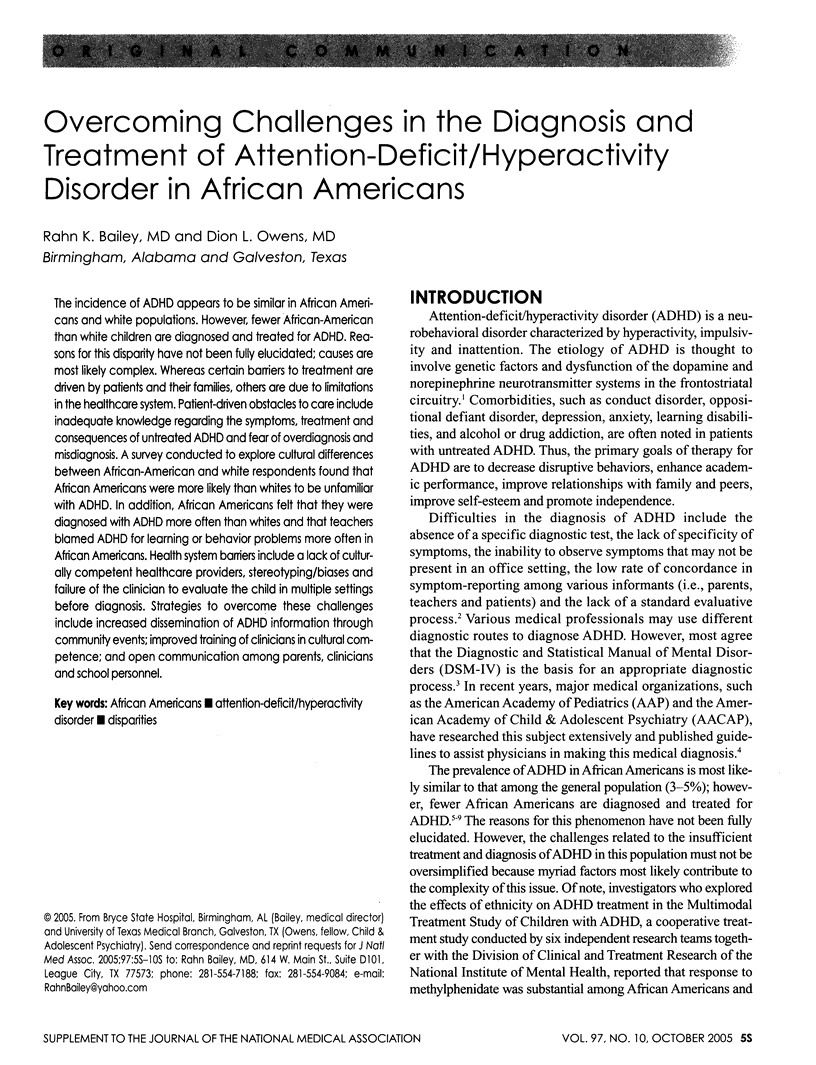
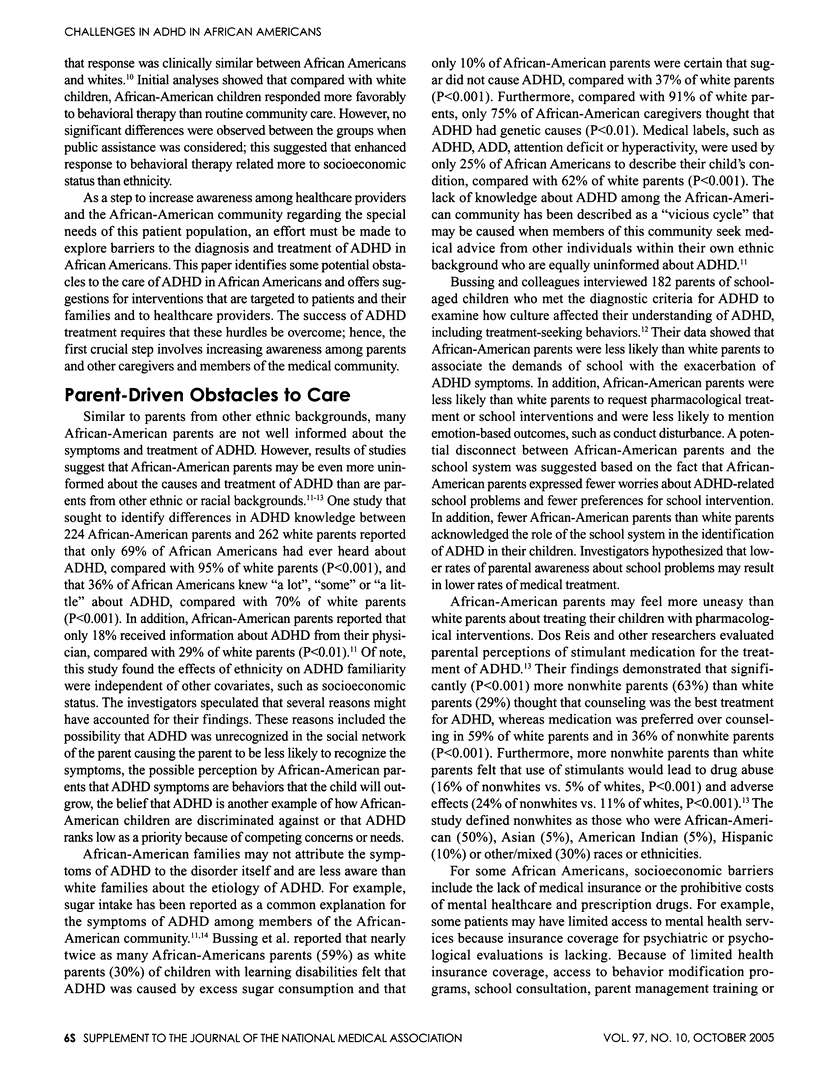
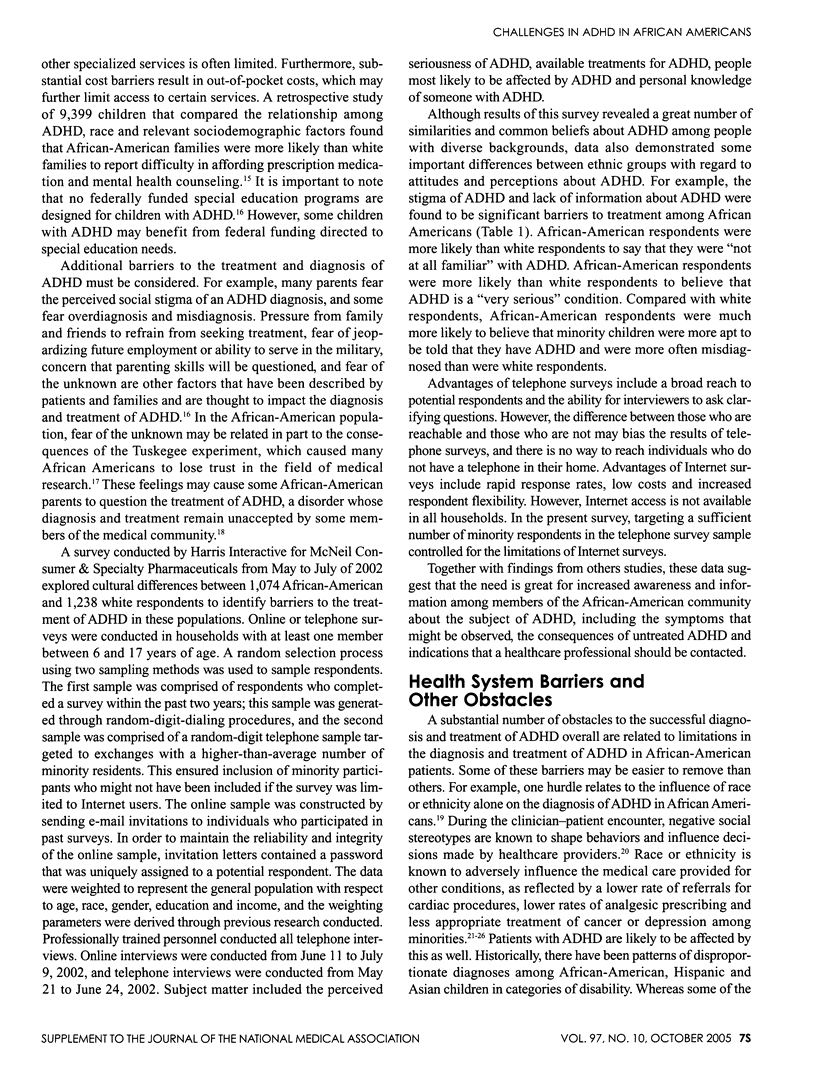

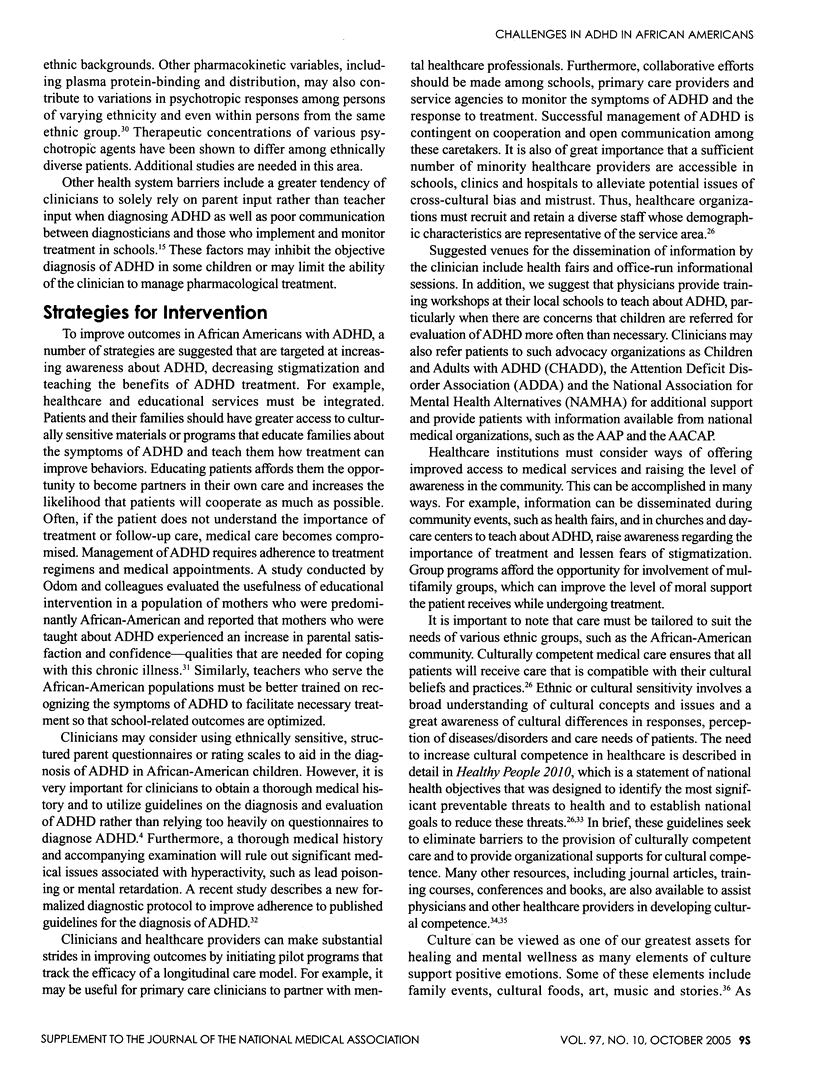
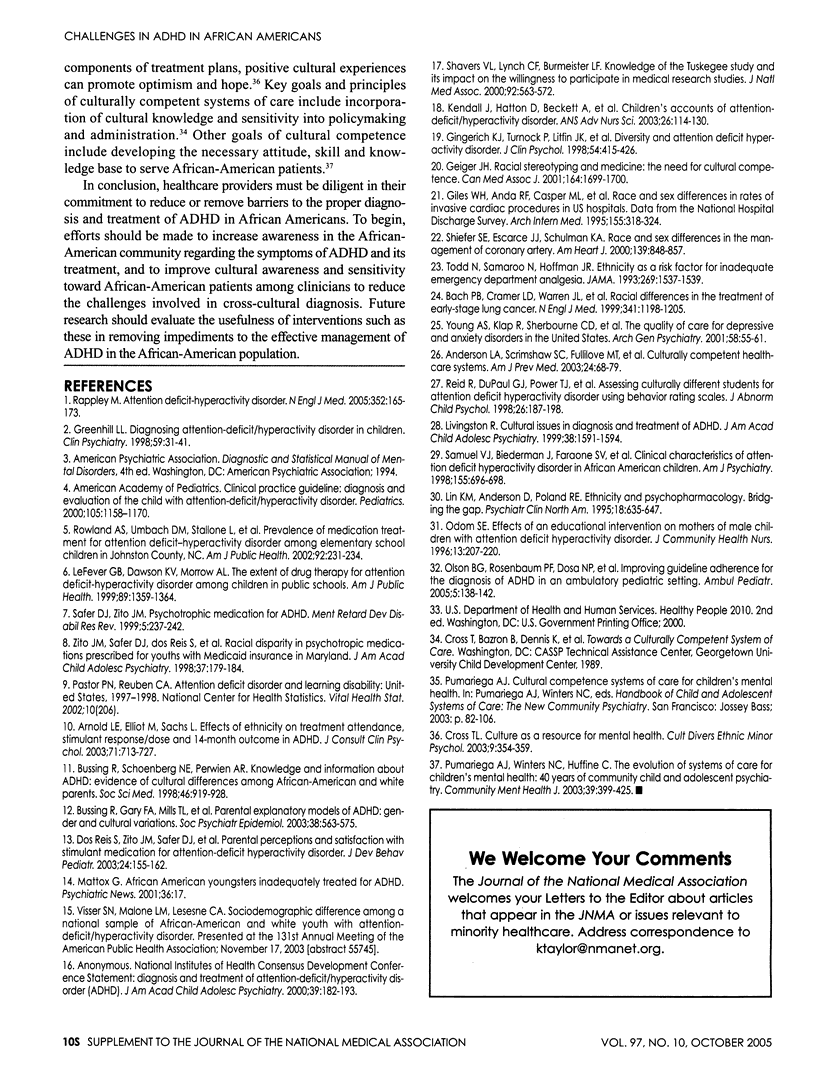
Selected References
These references are in PubMed. This may not be the complete list of references from this article.
- Arnold L. Eugene, Elliot Michael, Sachs Larry, Bird Hector, Kraemer Helena C., Wells Karen C., Abikoff Howard B., Comarda Anne, Conners C. Keith, Elliott Glen R. Effects of ethnicity on treatment attendance, stimulant response/dose, and 14-month outcome in ADHD. J Consult Clin Psychol. 2003 Aug;71(4):713–727. doi: 10.1037/0022-006x.71.4.713. [DOI] [PubMed] [Google Scholar]
- Bach P. B., Cramer L. D., Warren J. L., Begg C. B. Racial differences in the treatment of early-stage lung cancer. N Engl J Med. 1999 Oct 14;341(16):1198–1205. doi: 10.1056/NEJM199910143411606. [DOI] [PubMed] [Google Scholar]
- Bussing R., Schoenberg N. E., Perwien A. R. Knowledge and information about ADHD: evidence of cultural differences among African-American and white parents. Soc Sci Med. 1998 Apr;46(7):919–928. doi: 10.1016/s0277-9536(97)00219-0. [DOI] [PubMed] [Google Scholar]
- Bussing Regina, Gary Faye A., Mills Terry L., Garvan Cynthia Wilson. Parental explanatory models of ADHD: gender and cultural variations. Soc Psychiatry Psychiatr Epidemiol. 2003 Oct;38(10):563–575. doi: 10.1007/s00127-003-0674-8. [DOI] [PubMed] [Google Scholar]
- Cross Terry L. Culture as a resource for mental health. Cultur Divers Ethnic Minor Psychol. 2003 Nov;9(4):354–359. doi: 10.1037/1099-9809.9.4.354. [DOI] [PubMed] [Google Scholar]
- Dosreis Susan, Zito Julie Magno, Safer Daniel J., Soeken Karen L., Mitchell John W., Jr, Ellwood Leslie C. Parental perceptions and satisfaction with stimulant medication for attention-deficit hyperactivity disorder. J Dev Behav Pediatr. 2003 Jun;24(3):155–162. doi: 10.1097/00004703-200306000-00004. [DOI] [PubMed] [Google Scholar]
- Geiger H. J. Racial stereotyping and medicine: the need for cultural competence. CMAJ. 2001 Jun 12;164(12):1699–1700. [PMC free article] [PubMed] [Google Scholar]
- Gingerich K. J., Turnock P., Litfin J. K., Rosén L. A. Diversity and attention deficit hyperactivity disorder. J Clin Psychol. 1998 Jun;54(4):415–426. doi: 10.1002/(sici)1097-4679(199806)54:4<415::aid-jclp3>3.0.co;2-m. [DOI] [PubMed] [Google Scholar]
- Greenhill L. L. Diagnosing attention-deficit/hyperactivity disorder in children. J Clin Psychiatry. 1998;59 (Suppl 7):31–41. [PubMed] [Google Scholar]
- LeFever G. B., Dawson K. V., Morrow A. L. The extent of drug therapy for attention deficit-hyperactivity disorder among children in public schools. Am J Public Health. 1999 Sep;89(9):1359–1364. doi: 10.2105/ajph.89.9.1359. [DOI] [PMC free article] [PubMed] [Google Scholar]
- Lin K. M., Anderson D., Poland R. E. Ethnicity and psychopharmacology. Bridging the gap. Psychiatr Clin North Am. 1995 Sep;18(3):635–647. [PubMed] [Google Scholar]
- Livingston R. Cultural issues in diagnosis and treatment of ADHD. J Am Acad Child Adolesc Psychiatry. 1999 Dec;38(12):1591–1594. doi: 10.1097/00004583-199912000-00021. [DOI] [PubMed] [Google Scholar]
- Odom S. E. Effects of an educational intervention on mothers of male children with attention deficit hyperactivity disorder. J Community Health Nurs. 1996;13(4):207–220. doi: 10.1207/s15327655jchn1304_1. [DOI] [PubMed] [Google Scholar]
- Olson Brad G., Rosenbaum Paula F., Dosa Nienke P., Roizen Nancy J. Improving guideline adherence for the diagnosis of ADHD in an ambulatory pediatric setting. Ambul Pediatr. 2005 May-Jun;5(3):138–142. doi: 10.1367/A04-047R.1. [DOI] [PubMed] [Google Scholar]
- Pumariega Andres J., Winters Nancy C., Huffine Charles. The evolution of systems of care for children's mental health: forty years of community child and adolescent psychiatry. Community Ment Health J. 2003 Oct;39(5):399–425. doi: 10.1023/a:1025808902438. [DOI] [PubMed] [Google Scholar]
- Rappley Marsha D. Clinical practice. Attention deficit-hyperactivity disorder. N Engl J Med. 2005 Jan 13;352(2):165–173. doi: 10.1056/NEJMcp032387. [DOI] [PubMed] [Google Scholar]
- Reid R., DuPaul G. J., Power T. J., Anastopoulos A. D., Rogers-Adkinson D., Noll M. B., Riccio C. Assessing culturally different students for attention deficit hyperactivity disorder using behavior rating scales. J Abnorm Child Psychol. 1998 Jun;26(3):187–198. doi: 10.1023/a:1022620217886. [DOI] [PubMed] [Google Scholar]
- Rowland Andrew S., Umbach David M., Stallone Lil, Naftel A. Jack, Bohlig E. Michael, Sandler Dale P. Prevalence of medication treatment for attention deficit-hyperactivity disorder among elementary school children in Johnston County, North Carolina. Am J Public Health. 2002 Feb;92(2):231–234. doi: 10.2105/ajph.92.2.231. [DOI] [PMC free article] [PubMed] [Google Scholar]
- Samuel V. J., Biederman J., Faraone S. V., George P., Mick E., Thornell A., Curtis S., Taylor A., Brome D. Clinical characteristics of attention deficit hyperactivity disorder in African American children. Am J Psychiatry. 1998 May;155(5):696–698. doi: 10.1176/ajp.155.5.696. [DOI] [PubMed] [Google Scholar]
- Shavers V. L., Lynch C. F., Burmeister L. F. Knowledge of the Tuskegee study and its impact on the willingness to participate in medical research studies. J Natl Med Assoc. 2000 Dec;92(12):563–572. [PMC free article] [PubMed] [Google Scholar]
- Todd K. H., Samaroo N., Hoffman J. R. Ethnicity as a risk factor for inadequate emergency department analgesia. JAMA. 1993 Mar 24;269(12):1537–1539. [PubMed] [Google Scholar]
- Zito J. M., Safer D. J., dosReis S., Riddle M. A. Racial disparity in psychotropic medications prescribed for youths with Medicaid insurance in Maryland. J Am Acad Child Adolesc Psychiatry. 1998 Feb;37(2):179–184. doi: 10.1097/00004583-199802000-00010. [DOI] [PubMed] [Google Scholar]


